Sample Assignment on Allergic
VerifiedAdded on 2021/05/31
|5
|1417
|38
AI Summary
Contribute Materials
Your contribution can guide someone’s learning journey. Share your
documents today.
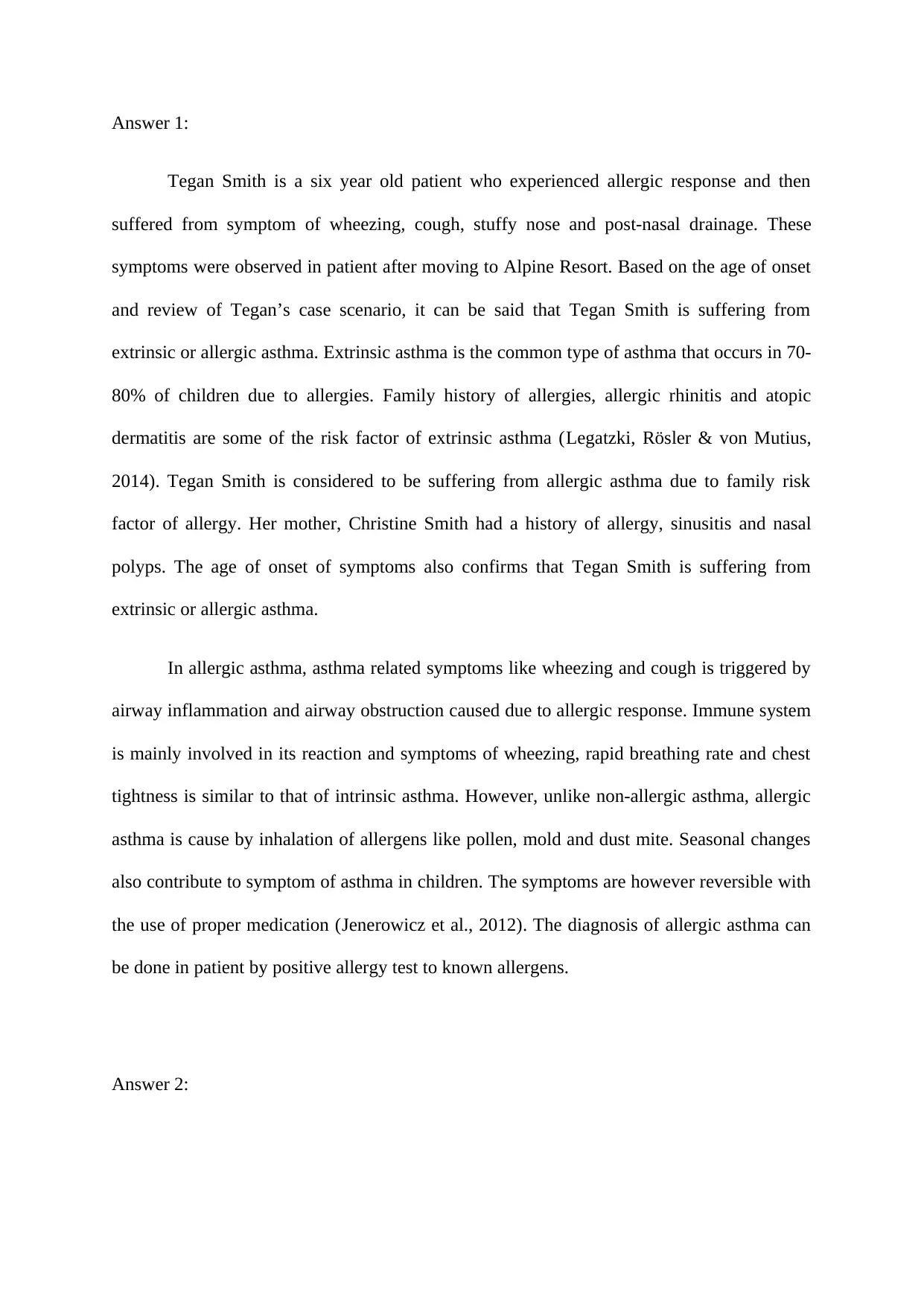
Answer 1:
Tegan Smith is a six year old patient who experienced allergic response and then
suffered from symptom of wheezing, cough, stuffy nose and post-nasal drainage. These
symptoms were observed in patient after moving to Alpine Resort. Based on the age of onset
and review of Tegan’s case scenario, it can be said that Tegan Smith is suffering from
extrinsic or allergic asthma. Extrinsic asthma is the common type of asthma that occurs in 70-
80% of children due to allergies. Family history of allergies, allergic rhinitis and atopic
dermatitis are some of the risk factor of extrinsic asthma (Legatzki, Rösler & von Mutius,
2014). Tegan Smith is considered to be suffering from allergic asthma due to family risk
factor of allergy. Her mother, Christine Smith had a history of allergy, sinusitis and nasal
polyps. The age of onset of symptoms also confirms that Tegan Smith is suffering from
extrinsic or allergic asthma.
In allergic asthma, asthma related symptoms like wheezing and cough is triggered by
airway inflammation and airway obstruction caused due to allergic response. Immune system
is mainly involved in its reaction and symptoms of wheezing, rapid breathing rate and chest
tightness is similar to that of intrinsic asthma. However, unlike non-allergic asthma, allergic
asthma is cause by inhalation of allergens like pollen, mold and dust mite. Seasonal changes
also contribute to symptom of asthma in children. The symptoms are however reversible with
the use of proper medication (Jenerowicz et al., 2012). The diagnosis of allergic asthma can
be done in patient by positive allergy test to known allergens.
Answer 2:
Tegan Smith is a six year old patient who experienced allergic response and then
suffered from symptom of wheezing, cough, stuffy nose and post-nasal drainage. These
symptoms were observed in patient after moving to Alpine Resort. Based on the age of onset
and review of Tegan’s case scenario, it can be said that Tegan Smith is suffering from
extrinsic or allergic asthma. Extrinsic asthma is the common type of asthma that occurs in 70-
80% of children due to allergies. Family history of allergies, allergic rhinitis and atopic
dermatitis are some of the risk factor of extrinsic asthma (Legatzki, Rösler & von Mutius,
2014). Tegan Smith is considered to be suffering from allergic asthma due to family risk
factor of allergy. Her mother, Christine Smith had a history of allergy, sinusitis and nasal
polyps. The age of onset of symptoms also confirms that Tegan Smith is suffering from
extrinsic or allergic asthma.
In allergic asthma, asthma related symptoms like wheezing and cough is triggered by
airway inflammation and airway obstruction caused due to allergic response. Immune system
is mainly involved in its reaction and symptoms of wheezing, rapid breathing rate and chest
tightness is similar to that of intrinsic asthma. However, unlike non-allergic asthma, allergic
asthma is cause by inhalation of allergens like pollen, mold and dust mite. Seasonal changes
also contribute to symptom of asthma in children. The symptoms are however reversible with
the use of proper medication (Jenerowicz et al., 2012). The diagnosis of allergic asthma can
be done in patient by positive allergy test to known allergens.
Answer 2:
Secure Best Marks with AI Grader
Need help grading? Try our AI Grader for instant feedback on your assignments.
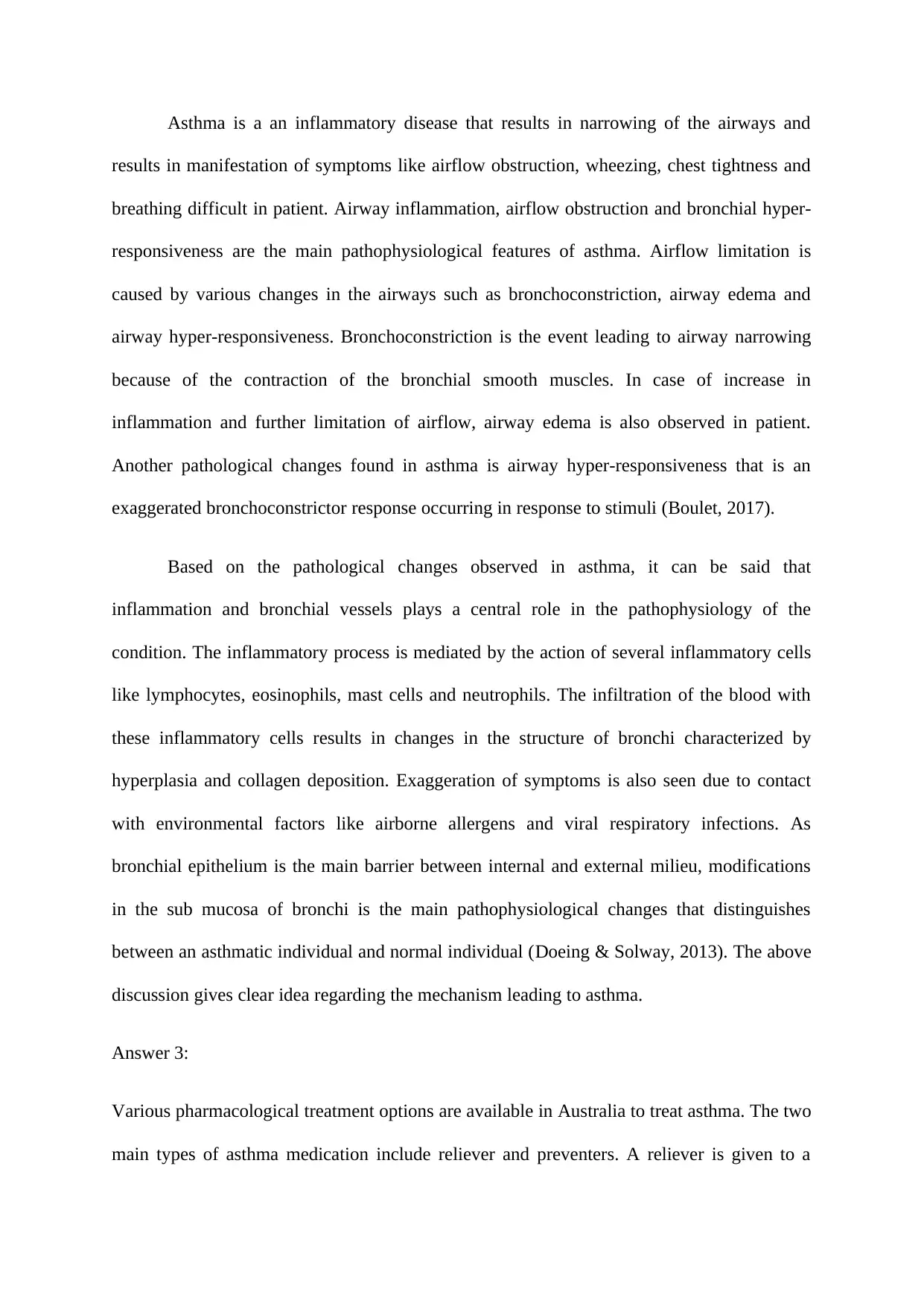
Asthma is a an inflammatory disease that results in narrowing of the airways and
results in manifestation of symptoms like airflow obstruction, wheezing, chest tightness and
breathing difficult in patient. Airway inflammation, airflow obstruction and bronchial hyper-
responsiveness are the main pathophysiological features of asthma. Airflow limitation is
caused by various changes in the airways such as bronchoconstriction, airway edema and
airway hyper-responsiveness. Bronchoconstriction is the event leading to airway narrowing
because of the contraction of the bronchial smooth muscles. In case of increase in
inflammation and further limitation of airflow, airway edema is also observed in patient.
Another pathological changes found in asthma is airway hyper-responsiveness that is an
exaggerated bronchoconstrictor response occurring in response to stimuli (Boulet, 2017).
Based on the pathological changes observed in asthma, it can be said that
inflammation and bronchial vessels plays a central role in the pathophysiology of the
condition. The inflammatory process is mediated by the action of several inflammatory cells
like lymphocytes, eosinophils, mast cells and neutrophils. The infiltration of the blood with
these inflammatory cells results in changes in the structure of bronchi characterized by
hyperplasia and collagen deposition. Exaggeration of symptoms is also seen due to contact
with environmental factors like airborne allergens and viral respiratory infections. As
bronchial epithelium is the main barrier between internal and external milieu, modifications
in the sub mucosa of bronchi is the main pathophysiological changes that distinguishes
between an asthmatic individual and normal individual (Doeing & Solway, 2013). The above
discussion gives clear idea regarding the mechanism leading to asthma.
Answer 3:
Various pharmacological treatment options are available in Australia to treat asthma. The two
main types of asthma medication include reliever and preventers. A reliever is given to a
results in manifestation of symptoms like airflow obstruction, wheezing, chest tightness and
breathing difficult in patient. Airway inflammation, airflow obstruction and bronchial hyper-
responsiveness are the main pathophysiological features of asthma. Airflow limitation is
caused by various changes in the airways such as bronchoconstriction, airway edema and
airway hyper-responsiveness. Bronchoconstriction is the event leading to airway narrowing
because of the contraction of the bronchial smooth muscles. In case of increase in
inflammation and further limitation of airflow, airway edema is also observed in patient.
Another pathological changes found in asthma is airway hyper-responsiveness that is an
exaggerated bronchoconstrictor response occurring in response to stimuli (Boulet, 2017).
Based on the pathological changes observed in asthma, it can be said that
inflammation and bronchial vessels plays a central role in the pathophysiology of the
condition. The inflammatory process is mediated by the action of several inflammatory cells
like lymphocytes, eosinophils, mast cells and neutrophils. The infiltration of the blood with
these inflammatory cells results in changes in the structure of bronchi characterized by
hyperplasia and collagen deposition. Exaggeration of symptoms is also seen due to contact
with environmental factors like airborne allergens and viral respiratory infections. As
bronchial epithelium is the main barrier between internal and external milieu, modifications
in the sub mucosa of bronchi is the main pathophysiological changes that distinguishes
between an asthmatic individual and normal individual (Doeing & Solway, 2013). The above
discussion gives clear idea regarding the mechanism leading to asthma.
Answer 3:
Various pharmacological treatment options are available in Australia to treat asthma. The two
main types of asthma medication include reliever and preventers. A reliever is given to a
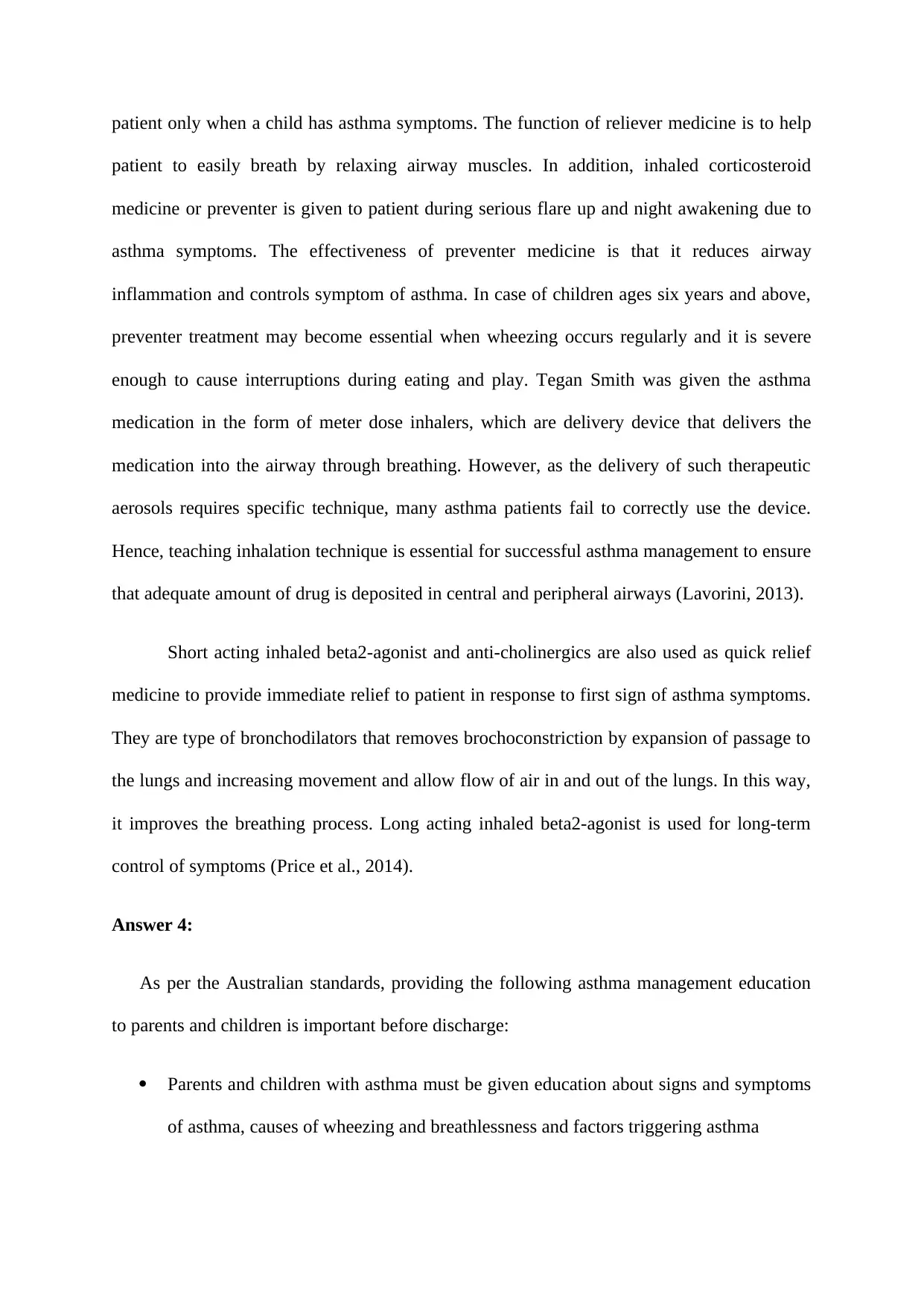
patient only when a child has asthma symptoms. The function of reliever medicine is to help
patient to easily breath by relaxing airway muscles. In addition, inhaled corticosteroid
medicine or preventer is given to patient during serious flare up and night awakening due to
asthma symptoms. The effectiveness of preventer medicine is that it reduces airway
inflammation and controls symptom of asthma. In case of children ages six years and above,
preventer treatment may become essential when wheezing occurs regularly and it is severe
enough to cause interruptions during eating and play. Tegan Smith was given the asthma
medication in the form of meter dose inhalers, which are delivery device that delivers the
medication into the airway through breathing. However, as the delivery of such therapeutic
aerosols requires specific technique, many asthma patients fail to correctly use the device.
Hence, teaching inhalation technique is essential for successful asthma management to ensure
that adequate amount of drug is deposited in central and peripheral airways (Lavorini, 2013).
Short acting inhaled beta2-agonist and anti-cholinergics are also used as quick relief
medicine to provide immediate relief to patient in response to first sign of asthma symptoms.
They are type of bronchodilators that removes brochoconstriction by expansion of passage to
the lungs and increasing movement and allow flow of air in and out of the lungs. In this way,
it improves the breathing process. Long acting inhaled beta2-agonist is used for long-term
control of symptoms (Price et al., 2014).
Answer 4:
As per the Australian standards, providing the following asthma management education
to parents and children is important before discharge:
Parents and children with asthma must be given education about signs and symptoms
of asthma, causes of wheezing and breathlessness and factors triggering asthma
patient to easily breath by relaxing airway muscles. In addition, inhaled corticosteroid
medicine or preventer is given to patient during serious flare up and night awakening due to
asthma symptoms. The effectiveness of preventer medicine is that it reduces airway
inflammation and controls symptom of asthma. In case of children ages six years and above,
preventer treatment may become essential when wheezing occurs regularly and it is severe
enough to cause interruptions during eating and play. Tegan Smith was given the asthma
medication in the form of meter dose inhalers, which are delivery device that delivers the
medication into the airway through breathing. However, as the delivery of such therapeutic
aerosols requires specific technique, many asthma patients fail to correctly use the device.
Hence, teaching inhalation technique is essential for successful asthma management to ensure
that adequate amount of drug is deposited in central and peripheral airways (Lavorini, 2013).
Short acting inhaled beta2-agonist and anti-cholinergics are also used as quick relief
medicine to provide immediate relief to patient in response to first sign of asthma symptoms.
They are type of bronchodilators that removes brochoconstriction by expansion of passage to
the lungs and increasing movement and allow flow of air in and out of the lungs. In this way,
it improves the breathing process. Long acting inhaled beta2-agonist is used for long-term
control of symptoms (Price et al., 2014).
Answer 4:
As per the Australian standards, providing the following asthma management education
to parents and children is important before discharge:
Parents and children with asthma must be given education about signs and symptoms
of asthma, causes of wheezing and breathlessness and factors triggering asthma
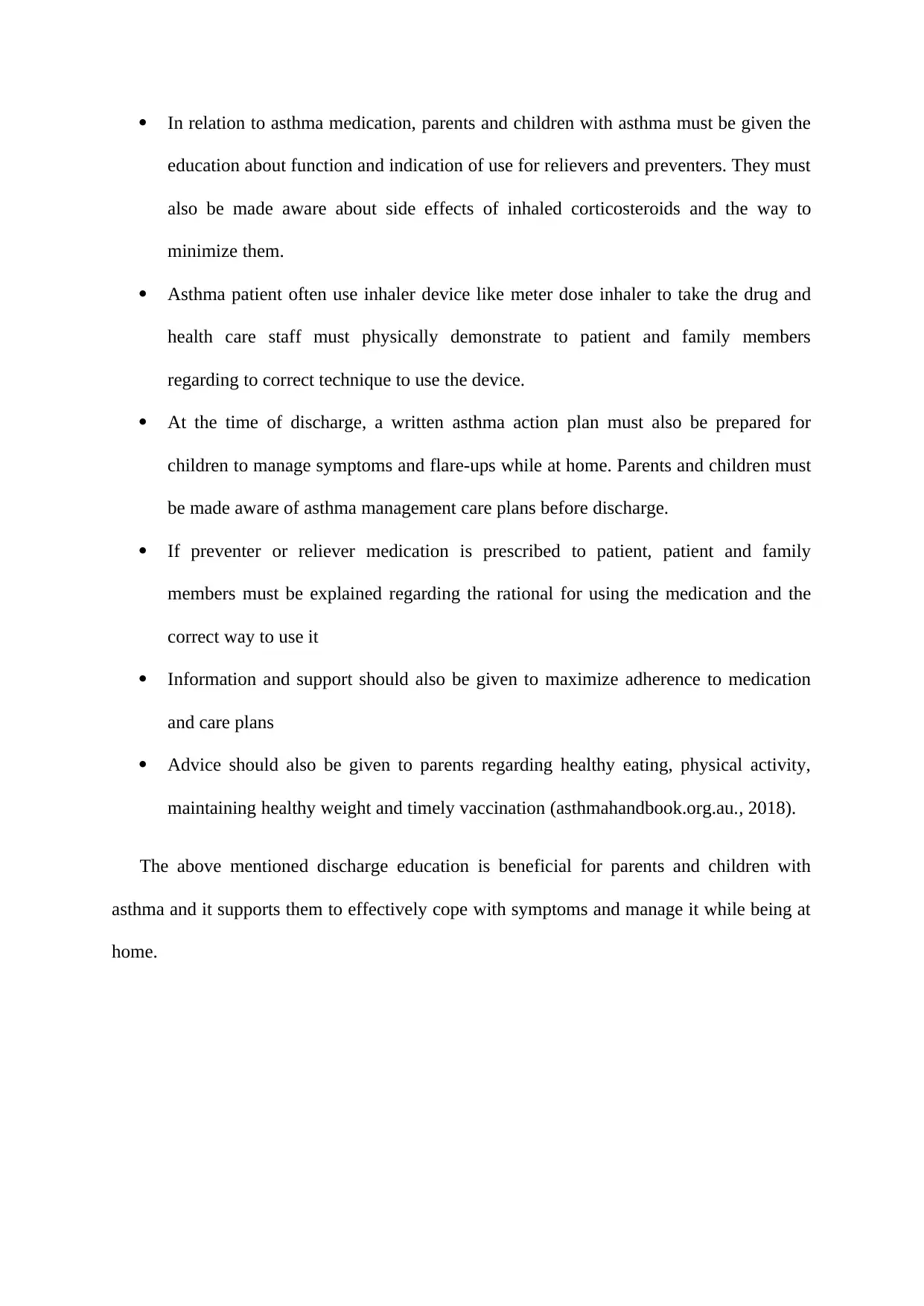
In relation to asthma medication, parents and children with asthma must be given the
education about function and indication of use for relievers and preventers. They must
also be made aware about side effects of inhaled corticosteroids and the way to
minimize them.
Asthma patient often use inhaler device like meter dose inhaler to take the drug and
health care staff must physically demonstrate to patient and family members
regarding to correct technique to use the device.
At the time of discharge, a written asthma action plan must also be prepared for
children to manage symptoms and flare-ups while at home. Parents and children must
be made aware of asthma management care plans before discharge.
If preventer or reliever medication is prescribed to patient, patient and family
members must be explained regarding the rational for using the medication and the
correct way to use it
Information and support should also be given to maximize adherence to medication
and care plans
Advice should also be given to parents regarding healthy eating, physical activity,
maintaining healthy weight and timely vaccination (asthmahandbook.org.au., 2018).
The above mentioned discharge education is beneficial for parents and children with
asthma and it supports them to effectively cope with symptoms and manage it while being at
home.
education about function and indication of use for relievers and preventers. They must
also be made aware about side effects of inhaled corticosteroids and the way to
minimize them.
Asthma patient often use inhaler device like meter dose inhaler to take the drug and
health care staff must physically demonstrate to patient and family members
regarding to correct technique to use the device.
At the time of discharge, a written asthma action plan must also be prepared for
children to manage symptoms and flare-ups while at home. Parents and children must
be made aware of asthma management care plans before discharge.
If preventer or reliever medication is prescribed to patient, patient and family
members must be explained regarding the rational for using the medication and the
correct way to use it
Information and support should also be given to maximize adherence to medication
and care plans
Advice should also be given to parents regarding healthy eating, physical activity,
maintaining healthy weight and timely vaccination (asthmahandbook.org.au., 2018).
The above mentioned discharge education is beneficial for parents and children with
asthma and it supports them to effectively cope with symptoms and manage it while being at
home.
Secure Best Marks with AI Grader
Need help grading? Try our AI Grader for instant feedback on your assignments.
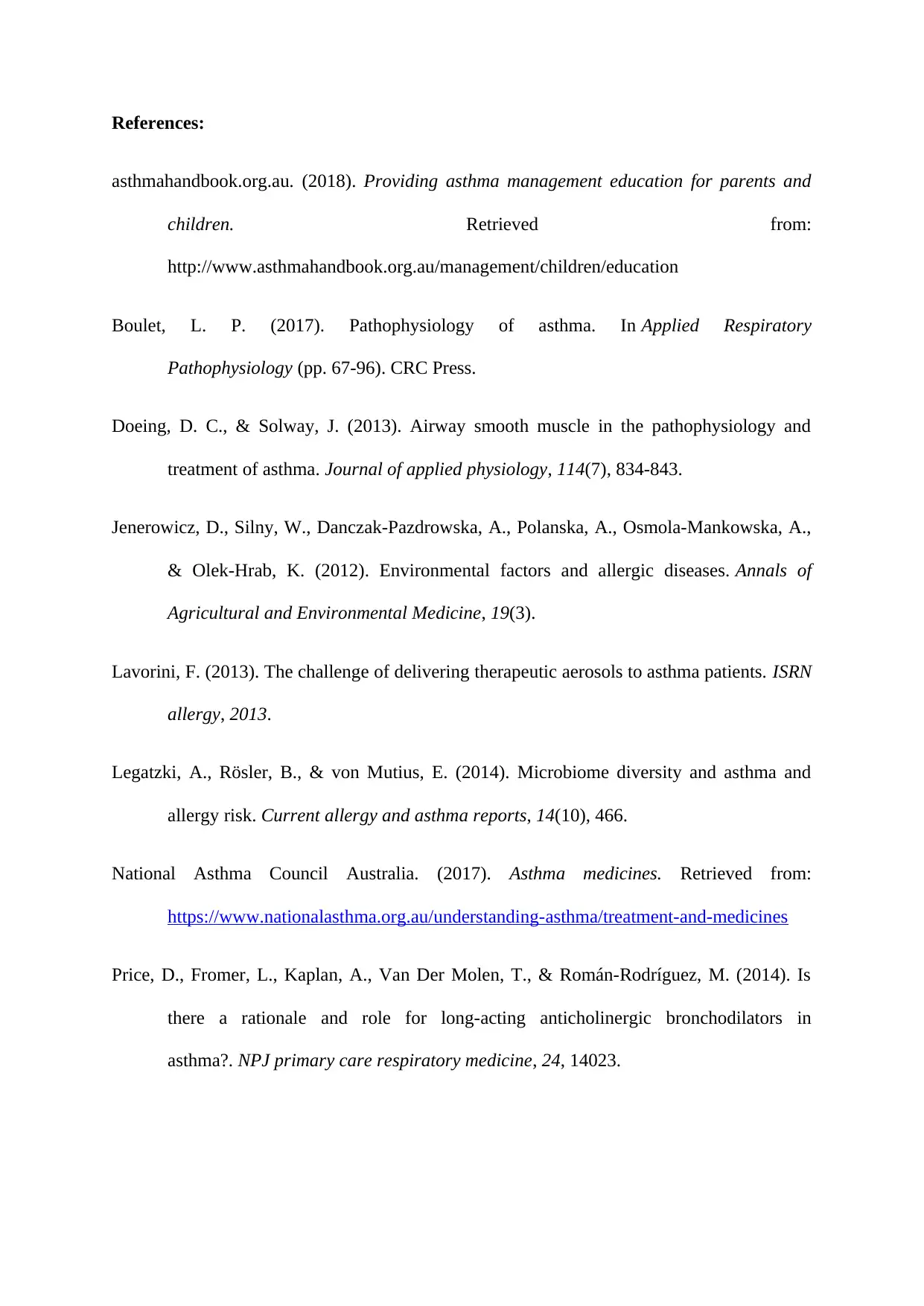
References:
asthmahandbook.org.au. (2018). Providing asthma management education for parents and
children. Retrieved from:
http://www.asthmahandbook.org.au/management/children/education
Boulet, L. P. (2017). Pathophysiology of asthma. In Applied Respiratory
Pathophysiology (pp. 67-96). CRC Press.
Doeing, D. C., & Solway, J. (2013). Airway smooth muscle in the pathophysiology and
treatment of asthma. Journal of applied physiology, 114(7), 834-843.
Jenerowicz, D., Silny, W., Danczak-Pazdrowska, A., Polanska, A., Osmola-Mankowska, A.,
& Olek-Hrab, K. (2012). Environmental factors and allergic diseases. Annals of
Agricultural and Environmental Medicine, 19(3).
Lavorini, F. (2013). The challenge of delivering therapeutic aerosols to asthma patients. ISRN
allergy, 2013.
Legatzki, A., Rösler, B., & von Mutius, E. (2014). Microbiome diversity and asthma and
allergy risk. Current allergy and asthma reports, 14(10), 466.
National Asthma Council Australia. (2017). Asthma medicines. Retrieved from:
https://www.nationalasthma.org.au/understanding-asthma/treatment-and-medicines
Price, D., Fromer, L., Kaplan, A., Van Der Molen, T., & Román-Rodríguez, M. (2014). Is
there a rationale and role for long-acting anticholinergic bronchodilators in
asthma?. NPJ primary care respiratory medicine, 24, 14023.
asthmahandbook.org.au. (2018). Providing asthma management education for parents and
children. Retrieved from:
http://www.asthmahandbook.org.au/management/children/education
Boulet, L. P. (2017). Pathophysiology of asthma. In Applied Respiratory
Pathophysiology (pp. 67-96). CRC Press.
Doeing, D. C., & Solway, J. (2013). Airway smooth muscle in the pathophysiology and
treatment of asthma. Journal of applied physiology, 114(7), 834-843.
Jenerowicz, D., Silny, W., Danczak-Pazdrowska, A., Polanska, A., Osmola-Mankowska, A.,
& Olek-Hrab, K. (2012). Environmental factors and allergic diseases. Annals of
Agricultural and Environmental Medicine, 19(3).
Lavorini, F. (2013). The challenge of delivering therapeutic aerosols to asthma patients. ISRN
allergy, 2013.
Legatzki, A., Rösler, B., & von Mutius, E. (2014). Microbiome diversity and asthma and
allergy risk. Current allergy and asthma reports, 14(10), 466.
National Asthma Council Australia. (2017). Asthma medicines. Retrieved from:
https://www.nationalasthma.org.au/understanding-asthma/treatment-and-medicines
Price, D., Fromer, L., Kaplan, A., Van Der Molen, T., & Román-Rodríguez, M. (2014). Is
there a rationale and role for long-acting anticholinergic bronchodilators in
asthma?. NPJ primary care respiratory medicine, 24, 14023.
1 out of 5
Related Documents
Your All-in-One AI-Powered Toolkit for Academic Success.
+13062052269
info@desklib.com
Available 24*7 on WhatsApp / Email
![[object Object]](/_next/static/media/star-bottom.7253800d.svg)
Unlock your academic potential
© 2024 | Zucol Services PVT LTD | All rights reserved.





